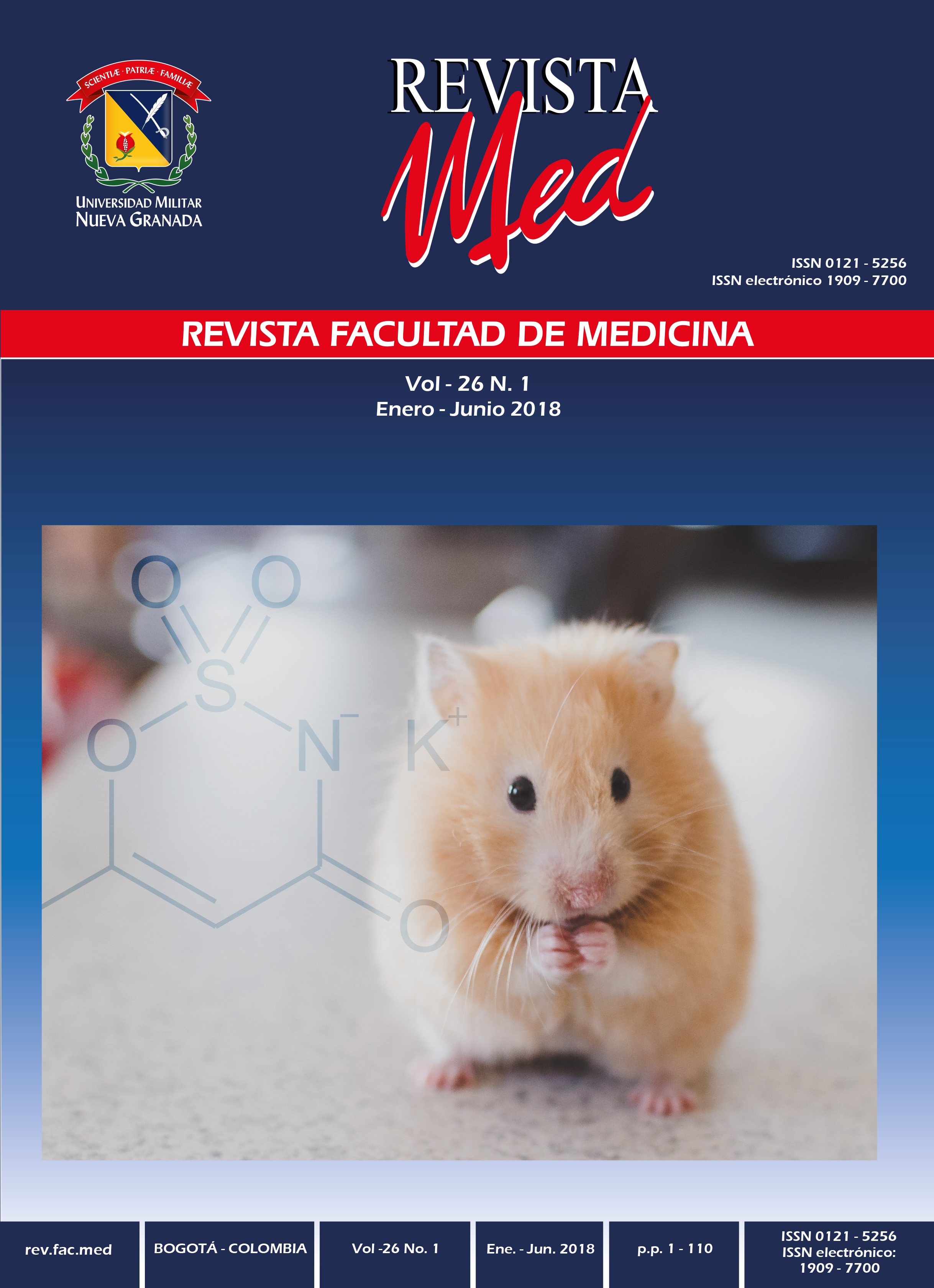Diagnostico de vértigo periférico para el médico de atención primaria
Abstract
Para los médicos de atención primaria, el paciente con sintomatología compatible con síndromes vestibulares constituye un desafío, debido a su amplia variedad de presentaciones y la dificultad en la diferenciación de las diversas patologías que ocasionan los síntomas. La necesidad de tener conceptos claros y actualizados sobre los mecanismos patológicos del vértigo surge en el momento de evaluar al paciente, para esto es necesario realizar un adecuado interrogatorio y un examen físico neurotológico completo que permita dilucidar un abordaje diagnóstico certero. El objetivo del presente artículo es presentar una revisión de la literatura actual, de las diferentes etiologías desencadenantes del vértigo periférico y a partir de sus características clínicas desarrollar un algoritmo diagnóstico que permita al profesional médico entender el mecanismo patológico del vértigo y proporcionar el tratamiento adecuado.Downloads
Languages:
esReferences
Hogue JD. Office Evaluation of Dizziness. Prim Care - Clin Off Pract [Internet]. Elsevier Inc; 2015;42(2):249–58.
Branch WT, Barton JS. Approach to the patient with dizziness. UpToDate. Philadelphia:Wolters Kluwer Health; 2014. topic 5099(version 11.0):1–8.
Saccomano SJ. Dizziness, vertigo and presyncope: what’s the difference? Nurse Pract 2012;37(12):46–52.
Desmond AL. Dizziness reference guide. Chatham (IL): Micromedical Technologies; 2009.
Jacquelien Dros MD, Otto R. Maarsingh MD, Henriëtte E. van der Horst MD PhD, Patrick J. Bindels MD PhD, Gerben ter Riet MD PhD, Henk C. van Weert MD PhD. Tests used to evaluate dizziness in primary care. CMAJ September 21, 2010 vol. 182 no. 13 First published July 19, 2010, doi: 10.1503/cmaj.080910.
Julia Sczepanek, Birgitt Wiese, Eva Hummers-Pradier, Carsten Kruschinski. Newly diagnosed incident dizziness of older patients: a follow-up study in primary care. BMC Family Practice 2011 12:58.
K Kroenke. Dizziness in Primary Care. West J Med. 1995 Jan; 162(1): 73–74.
Manual de otorrinolaringología y cirugía de cabeza y cuello, Augusto Peñaranda, editorial Amolca, 2007 capitulo 13 pg 117-118.
Ballve Moreno JL, Carrillo Muñoz R, Villar Balboa I, Effectiveness of the Epley's maneuver performed in primary care to treat posterior canal benign paroxysmal positional vertigo: study protocol for a randomized controlled trial. Trials. 2014 May 21;15:179. doi: 10.1186/1745-6215-15-179.
Molnar A, McGee S. Diagnosing and treating dizziness. Med Clin North Am. 2014;98(3):583–96.
Newman-Toker DE. Symptoms and signs of neuro-otologic disorders. Contin Lifelong Learn Neurol. 2012;18(5):1016–40.
Walker HK, Hall WD, Hurst JW, editors.Physical, and Laboratory Examinations. 3rd edition. Boston: Butterworths; 1990.
Post RE, Dickerson LM. Dizziness: A diagnostic approach. Am Fam Physician. 2010;82(4):361–8.
Hoffman RM, Einstadter D, Kroenke K. Evaluating dizziness. Am J Med. 1999;107(5):468-478.
Wasay M, Dubey N, Bakshi R. Dizziness and yield of emergency head CT scan: is it cost effective? Emerg Med J. 2005;22(4):312.
Eva Grill, Mathias Penger, and Erna Kentala. Health care utilization, prognosis and outcomes of vestibular disease in primary care settings: systematic review. J Neurol. 2016; 263: 36–44.
Guillermo Plaza Mayora, Tomás Onrubiab y Alberto Hernández Carnicero. Diagnóstico y tratamiento del vértigo periférico. Jano 23 oct 2009 . N.º 1.749.
Andrés Soto-Varela, Ismael Arán-González, et al . Clasificación de los vértigos periféricos de la Comisión de Otoneurología de la Sociedad Española de Otorrinolaringología, concordancia diagnóstica y actualización (versión 2, año 2011). Vol. 63. Núm. 02. Marzo 2012 - Abril 2012.
Daljit Singh Sura, Stephen newell. Vertigo- Diagnosis and management in primary care. Vertigo. BJMP 2010;3 (4):a351.
Carios Stott C, Patricio Tabilo C, Nicolás Albertz A, Cesar Toro A. Fístula perilinfática traumática: Entidad otorrinolaringológica poco frecuente. Rev. Otorrinolaringol. Cir. Cabeza Cuello 2008; 68: 283-287.
Silvia Montes, Samantha Rodríguez-Muguruza, Constanza Viña, Alejandro Olivé. Síndrome de Cogan. Vol. 15. Núm. 01. Enero 2014 - Marzo 2014.
Chawla N, olshaker JS - Guia de tratamiento de vertigo. Med Clin N Am2006.
Brandt T, Dieterich M (1994) Vestibular paroxysmia: vascular compression of the eighth nerve? Lancet 343:798–799.
Brandt T, Strupp M, Dieterich M. Vestibular paroxysmia: a treatable neurovascular cross-compression syndrome. J Neurol [Internet]. Springer Berlin Heidelberg; 2016;263(S1):90–6.
Kunel'skaya NL, Guseva AL, Baibakova EV, Chistov SD, Chugunova MA. The efficacious algorithm for the diagnostics and treatment of benign paroxysmal positional vertigo. Vestn Otorinolaringol. 2015;80(5):19-22
Leornardo Ordoñez. Guia para el diagnostico y tratamiento del vertigo paroxistico periferico benigno- Guias oficiales ACORL Basadas en la evidencia.
Vertigo and Dizziness Common Complaints, Thomas Brandt, Ed.Springer-Verlag London Limited 2005 Pg 115 – 121.
Al Felasi M, Pierre G, Mondain M, Uziel A, Venail F. Perilymphatic fistula of the round window. Eur Ann Otorhinolaryngol Head Neck Dis [Internet]. Elsevier Masson SAS; 2011;128(3):139–41.
Markou K, Rachovitsas D, Veros K, Tsiropoulos G, Tsalighopoulos M, Psillas G. Perilymphatic fistula of the round window after whiplash injury: Another cause of inner ear conductive hearing loss. Am J Otolaryngol - Head Neck Med Surg [Internet]. Elsevier Inc.; 2014;35(6):822–5.
Yew A, Zarinkhou G, Spasic M, Trang A, Gopen Q, Yang I. Characteristics and management of superior semicircular canal dehiscence. J Neurol Surgery, Part B Skull Base. 2012;73(6):365–70.
Chien WW, Carey JP, Minor LB. Canal dehiscence. Curr Opin Neurol. 2011;24(1):25–31.
Chodkiewicz HM, Cohen PR, Robinson FW, Rae ML. Ramsay hunt syndrome revisited. Cutis. 2013;91(4):181–4.
Harcourt J, Barraclough K, Bronstein AM. Meniere’s disease. Bmj. 2014;349(November):g6544.
Grkov R, Pyyk I, Zou J, Kentala E. What is Meniere’s disease? A contemporary re-evaluation of endolymphatic hydrops. J Neurol. 2016;263:71–81.
Nakashima T NS, Pyykko I, Poe D (2015) New outlook on Meniere’s disease. Nature rewiews.
Leonardo Ordoñez. Guia para el diagnostico y tratamiento de la enfermedad de Meniere. Guias oficiales ACORL Basadas en la evidencia.
Singer O. Cogan and Behcet syndromes. Rheum Dis Clin North Am [Internet]. Elsevier Inc; 2015;41(1):75–91.
Kessel A, Vadasz Z, Toubi E. Autoimmunity Reviews Cogan syndrome — Pathogenesis , clinical variants and treatment approaches. Autoimmun Rev [Internet]. Elsevier B.V.; 2014;13(4-5):351–4.
Garcia-Berrocal JR, Gorriz C, Ramirez-Camacho R, Trinidad A, Ibanez A, Rodriguez Valiente A, et al. Otosyphilis mimics immune disorders of the inner ear. Acta Otolaryngol. 2006;126(7):679–84.
Phillips JS, Gaunt A, Phillips DR. Otosyphilis: a neglected diagnosis? Otol Neurotol. 2014;35(6):1011–3.
Neuhauser HK, Lempert T. Vertigo: epidemiologic aspects. Semin Neurol 2009;29(5):473–81.
Murtagh J. Dizziness (vertigo). Aust Fam Physician [Internet]. Elsevier Inc; 1991;20(10):1483–5, 1488, 1490.
Cohn B. Can bedside oculomotor (HINTS) testing differentiate central from peripheral causes of vertigo? Ann Emerg Med [Internet]. American College of Emergency Physicians; 2014;64(3):265–8.
Algarra Jaime, Morera C., Lecciones de otorrinolaringología aplicada, editorial Glosa, 2006, Pg 370- 372.
Friedman JM. Post-traumatic vertigo. Med Heal R I. 2004;87(10):296–300.
Fife TD, Kalra D. Persistent vertigo and dizziness after mild traumatic brain injury. Ann N Y Acad Sci. 2015;1343(1):97–105.
Sedó-Cabezón L, Boadas-Vaello P, Soler-Martn C, Llorens J. Vestibular damage in chronic ototoxicity: A mini-review. Neurotoxicology. 2014;43:217.
Myrseth E, Pedersen PH, Møller P, Lund-Johansen M. Treatment of vestibular schwannomas. Why, when and how? Acta Neurochir (Wien). 2007;149(7):647–60.
Myrseth E, Moller P, Goplen F, Wentzel-Larsen T, Lund-Johansen M (2006) Untreated vestibular schwannoma: vertigo is a powerful predictor for health-related quality of life. Neurosurgery 59: 67–7.
Baumann I, Plinkert PK, Quality of life in patients with vestibular schwannoma; DOI: 10.1007/s00106-017-0371-7












